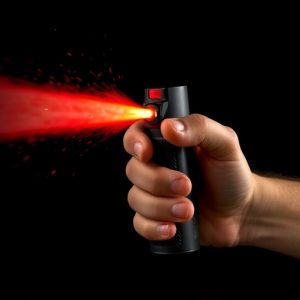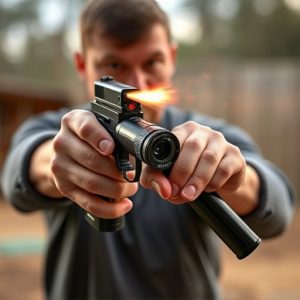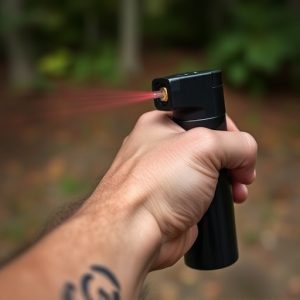Treating Pepper Spray Exposure: A Comprehensive Guide
Non-lethal deterrent devices like pepper spray, tasers, and stun guns provide personal security with…….
Non-lethal deterrent devices like pepper spray, tasers, and stun guns provide personal security without permanent harm. To treat pepper spray exposure, immediately move to fresh air, wash affected areas with soap and water for 15-20 minutes, and seek medical attention if breathing becomes difficult. Proper training on usage and cross-contamination prevention is vital for safe and effective treatment.
“Personal security is a growing concern in today’s world, prompting the search for effective non-lethal deterrent devices. This article provides an extensive look at these innovative tools, with a particular focus on pepper spray—its mechanics, risks, and how to mitigate exposure.
We’ll explore ‘Understanding Non-Lethal Deterrent Devices’ to uncover their role in personal safety. Then, delve into ‘The Science Behind Pepper Spray’ to grasp its effects and potential dangers. Lastly, we present a comprehensive ‘Step-by-Step Guide on Effective Strategies for Treating Pepper Spray Exposure,’ offering practical advice for those affected.”
- Understanding Non-Lethal Deterrent Devices: A Comprehensive Overview
- The Science Behind Pepper Spray: How It Works and Potential Exposure Risks
- Effective Strategies for Treating Pepper Spray Exposure: A Step-by-Step Guide
Understanding Non-Lethal Deterrent Devices: A Comprehensive Overview
Non-lethal deterrent devices are tools designed to incapacitate or deter potential threats without causing permanent harm or death. These include pepper spray, tasers, stun guns, and noise makers. Pepper spray, for instance, is a popular choice due to its effectiveness in temporarily blinding and disorienting assailants, allowing individuals to escape safely. Understanding how these devices work and their limitations is crucial when considering personal security.
Knowing How to Treat Pepper Spray Exposure is essential as well. If exposed, victims should immediately seek fresh air by moving to an open area. Washing the affected areas with soap and water can help reduce irritation. Medical attention might be necessary if symptoms persist or are severe. This proactive approach ensures that individuals not only know how to use non-lethal deterrents effectively but also how to manage potential side effects, enhancing their overall safety and security.
The Science Behind Pepper Spray: How It Works and Potential Exposure Risks
Pepper spray, a popular non-lethal deterrent, uses capsaicin, the active ingredient found in chili peppers, to cause temporary blindness, coughing, and difficulty breathing. When deployed, the spray forms a dense cloud that can disable an assailant for several minutes, providing ample time for escape or assistance. However, understanding how it works is crucial when considering its use and potential exposure risks.
Exposure to pepper spray can occur through inhalation of the aerosolized capsaicin, contact with eyes or skin, or ingestion. To treat pepper spray exposure, immediate action is essential. In case of eye contact, flush thoroughly with clean water for at least 15 minutes. For skin contact, wash the affected area with soap and warm water, also for at least 15 minutes. If inhaled, move to fresh air immediately and seek medical attention if symptoms persist or worsen. Proper training on how to use pepper spray safely, including awareness of potential cross-contamination, is vital to mitigate exposure risks.
Effective Strategies for Treating Pepper Spray Exposure: A Step-by-Step Guide
How to Treat Pepper Spray Exposure
If exposed to pepper spray, the first step is to get to a safe, well-ventilated area as quickly as possible. Remove any clothing or accessories that may have come into contact with the spray, being careful not to rub your eyes or face. Pepper spray can cause discomfort and irritation, so it’s crucial to stay calm and follow specific steps for treatment.
Rinse the affected areas thoroughly with plenty of clean water for at least 15 minutes. This helps dilute the pepper spray and alleviate its effects. For eye exposure, continue rinsing with water for at least 20 minutes while keeping your eyes open. If breathing becomes difficult, seek medical attention immediately. After rinsing, wash any clothing or items that may have been contaminated to prevent further contact with the skin or eyes.
In conclusion, understanding non-lethal deterrent devices, such as pepper spray, and knowing how to effectively treat exposure are crucial components of personal security. By grasping the science behind these agents and implementing practical treatment strategies, individuals can better navigate potentially dangerous situations. Remember that, in terms of self-defense, knowledge is power, and being prepared can make all the difference. To summarize, understanding How to Treat Pepper Spray Exposure is a vital step in empowering yourself with effective personal security tools.


